Read Reviews
The Best Outdoor Brooms
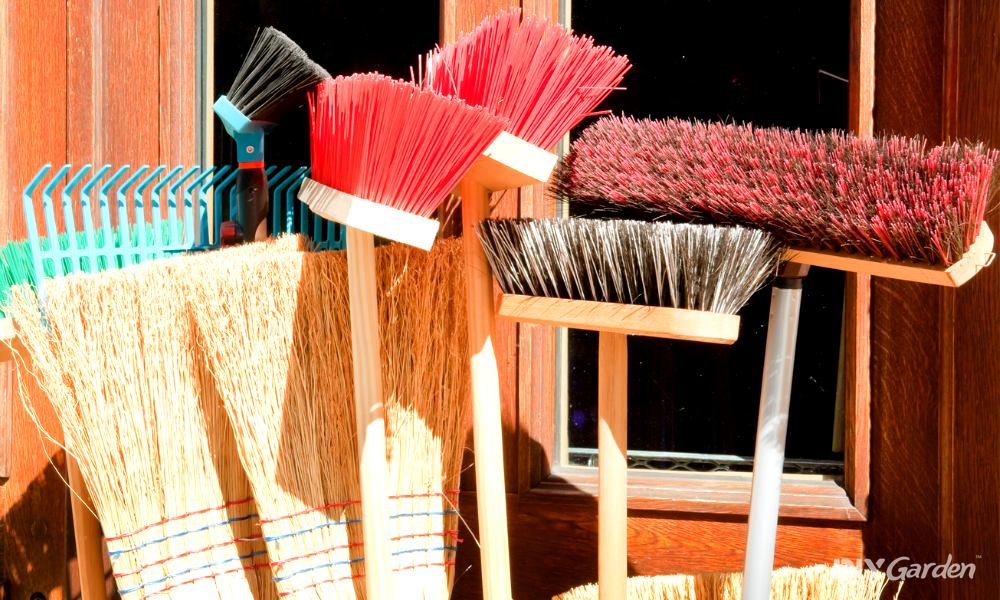
-
Harris Victory 45 cm Platform Broom
-
Draper Yard Broom 330mm
-
Harris Victory 90 cm Platform Broom
-
Charles Bentley 12" Natural Bassine Broom
-
Wolf-Garten B40M Multi-Change Patio Brush
Outdoor Broom Reviews
- Good budget option when comparing size with price
- 45 cm head is a reasonable size for patios and still able to get into some smaller areas
- Full head of bristles helps for sweeping up smaller debris
- Sturdy bristles are sufficiently firm for use on artificial lawns
- Best suited to lighter sweeping tasks as opposed to really scrubbing dirt and grime
- Wood has not been treated with any weather-proofing products
- No metal stay included to create secure attachment between broom head and shaft
- Head is held on to shaft with a single nail
It can be hard to find good quality items whilst working to a budget, but the Harris Victory 45 cm Platform Broom offers a reasonable combination of build quality and size considering its price.
It’s best suited to light work, as opposed to heavy-duty tasks, based on the thickness of the handle and the way it has been constructed. Unlike some other wooden brooms featured on this page, there is no metal stay included, so the connection between the head and shaft is simply held in by one metal nail. However, the bassine bristles are suitably stiff and full to catch smaller pieces of debris.
The 45 cm head is a reasonable size for working outside – large enough to cover bigger areas like patios, but still sufficiently narrow to get into some smaller spaces. It’s also lightweight at 1.1 kg so should be easy to work with.
Based on the cost and size of the broom, this is one of the best outdoor brooms for anyone sticking to a budget. However, it should not be expected to do the same heavy-duty work as more robust models. It’s best suited to light sweeping jobs, as opposed to removing dirt and grime via scrubbing.
Did you find this review helpful?
- Tough bristles can scrub paving and make them visibly cleaner
- Handle fits firmly into broom head creating a strong brush overall
- Works well for sweeping both wet and dry debris
- Long handle may feel a bit tall for users under 5'3"
Useful for sweeping both wet and dry debris, this Draper Yard Broom is sturdy, well-sized and good quality.
It comes with a Polypropylene/Sherbro mix head with long, tough bristles that work well on patios, concrete and driveways.
The wooden handle is 137 cm and fits solidly into the socket on the broom head, resulting in a robust tool for the yard. It’s tough enough to scrub decking and paths as well as deal with leaves, mud and building rubble.
Overall, this is one of the best outdoor brooms if you’re after something that will stand the test of time. It’s basic, with a simple design, and works well to scrub and clean hard surfaces outdoors.
Did you find this review helpful?
- Large size makes it a good choice for clearing big, open areas
- Head is twice the size of standard brooms so can cover same space in half the time
- Relatively light for size, making it easy to manoeuvre and manage
- Handle may eventually snap if too much pressure is applied
- Handle is a little short and may not be comfortable for users over 6' tall
Suitable for larger areas, this Harris Victory 90 cm Platform Broom measures 90 cm across and has hardwearing bassine bristles.
The wooden handle is reinforced with a metal stay, to keep a strong connection between the head and shaft. This creates a hardwearing broom that can be used in wet and dry environments, and for a range of tasks, including sweeping across large areas like garages and warehouses.
When used outside, it limits the amount of time required for cleaning big open spaces like stables, yards and patios. Being double the width of most standard brushes, it only needs to do half as many passes.
It offers a good compromise between size and price, with many similar brooms of the same size being more expensive. The quality is reasonable as well, although the handle may not be as strong as some other brooms. A little bit of care should be taken to make sure it is not put under too much pressure.
Overall, this is one of the best outdoor brooms for working in larger spaces – the combination of size and price makes it good value for money, and a good addition to the tool-shed.
Did you find this review helpful?
- The rubber grips can make the broom easier to hold onto, especially if grip strength is difficult
- Brush head is a good size for the majority of standard gardening jobs - it can fit into narrower corners too
- Bristles are strong enough to cope with textured flooring like flagged paving
- Ash wood head is constructed from FSC certified wood and has been sustainably sourced
- Easy to connect the shaft and head together for initial assembly
- Occasionally the top grip comes loose and requires securing in place
Comfort isn’t always the first thing you think of when sweeping, but the rubber grips on this Charles Bentley 12″ Natural Bassine Broom can make a noticeable difference. This could be particularly useful for anyone who struggles with grip whilst using tools.
The shaft is made from lightweight powder-coated steel and the 30 cm brush head has an ash wood construction. The timber has been FSC certified, meaning it comes from a sustainable source.
This is a good broom for slightly smaller patios, as it gets into difficult corners with ease. The bristles are made from natural bassine and are ideal for sweeping in dry conditions. They’re relatively stiff, and effective at removing leaves, soil and dust.
Both the wooden head and steel shaft have been given a weatherproof finish, so if the broom does get left outside it’s not the end of the world. However, best practise is to store it out of the elements when not in use.
Considering this broom’s price and quality, it’s one of the best outdoor brooms if you’re after value for money. It’s not as wide as some of the other products on this list, but it’ll get the job done and the comfortable grips could make a marked difference to some users.
Did you find this review helpful?
- Connection between head and pole shaft is secure, resulting in a hardwearing broom
- Interchangeable head only requires one shaft to be bought for multiple tools, giving an option to save on storage space
- PVC bristles are long lasting and thorough - they catch small pieces of debris
- Relatively wide brush head helps shorten time spent on sweeping jobs
- Bristles do not easily bend out of shape
- There can be a slight rattle from the connection between the head and pole
- Shaft needs to be purchased separately
If you’re short on space, this Wolf-Garten B40M Multi-Change Patio Brush is part of Wolf-Garten’s interchangeable tool head range. It doesn’t come with a shaft, but you can buy one separately that fits this brush head as well as other tools.
As a result, you can save space – by not having to store numerous long-handled tools – and money – by buying just the head which is cheaper than purchasing the whole tool.
This brush has PVC bristles that are tough and long lasting, and, at 40 cm wide, it efficiently sweeps patios and hard surfaces, clearing up all kinds of debris and scrubbing away stains.
You can choose the right pole for your height, minimising backache and fatigue, and the same shaft can then be used with a host of other interchangeable Wolf Garten tools like rakes and hoes.
The brush head ‘clicks’ into place on the shaft, creating a secure connection and resulting in a tough broom.
For anyone looking for a space-saving tool system, this is one of the best outdoor brushes to go for. Not only does it allow you to choose the most comfortable pole length, but the head is easy to store separately from the shaft. Plus, the brush itself is good quality and works well for cleaning.
Did you find this review helpful?
How to Choose the Best Outdoor Broom
An outdoor broom is a must-have for anyone who loves having a neat and tidy space. Whether it’s a patio, driveway or balcony, sweeping up leaves, dirt and debris can make a real difference to how the area looks.
Whilst most brooms follow the same basic principles, there are a few things to bear in mind that will help you choose the best outdoor broom for your particular space.
READ NEXT: The Best Artificial Grass Brushes & Sweepers
Broom Handle Length and Material
Broom handles can differ more than you might think, so it’s worth looking out for something that you’ll find genuinely comfortable to use. Finding something that you can use without stooping is ideal, as is having a comfortable grip.
Ideally, the handle of a broom should reach to just under your chin when it’s stood vertically upright. Therefore, it can help to get the tape measure out when reading broom specs in order to see how tall it will actually be. A little bit of variation is fine, but using this as a guide you’ll be able to tell if a broom is way too short or tall.
Another consideration is the handle material. Plastic is by far the cheapest material, and it’s also very lightweight. Plastic is weatherproof and won’t rust, but it’s not the sturdiest. It’s not uncommon for a broom with a plastic shaft to break after a while.
Wood and metal are both more durable than plastic, but they lack the weather resistance. Wood can rot over time, and metal may begin to rust. Provided you store your broom in a dry area, this shouldn’t be too much of a problem. Some metals are coated to make them more rust resistant, and some woods are pressure treated to make them less susceptible to rust.
Fibreglass is the final option for handle material. It’s lightweight yet extremely strong. The only downside is the cost – it’s expensive.
Some handles come with rubber grips on them, or you can add your own. This can help anyone who struggles with grip, and also make cold metal handles more pleasant to hold in the winter.
READ NEXT: The Best Garden Vacuums
Selecting the Right Size Broom Head
Broom heads can vary in width.
If you have a large balcony or patio, you may wish to buy a brush head that is 45 cm +. This will make it easy to clear a wider area in a shorter space of time, although wider brush heads are difficult to get into smaller spaces or around obstacles.
For smaller areas such as pathways between flower beds or small balconies, a narrower brush head (of around 30 cm) will be easier to use.
The head and handle are usually joined together at the base of the handle. Screw-in models tend to last a lot longer, and are better suited for heavy duty sweeping.
Bristle Material and Stiffness
The bristles can make a huge difference when it comes to how easy your broom is to use.
Most brooms use either synthetic PVC bristles, or bristles made from bassine. Bassine is a natural material, derived from dried palm leaves.
Whilst both types of bristle can be used when it’s wet, bassine bristles are more likely to get damaged if they are exposed to a lot of moisture. PVC bristles won’t be affected, so this may be a better choice if you want to use the broom for scrubbing with water.
Bristles can also vary in stiffness; stiff bristles are best for heavy-duty sweeping and they can be used to remove stubborn bits of debris.
For a quick surface sweep and lighter tasks, softer bristles tend to be best.
Also, bear in mind that stiff bristles can damage softer surfaces.
Outdoor Garden Broom FAQs
Certain brooms are designed for pushing, whilst others are designed for pulling. So, the short answer is – it depends on the broom! Very long-handled brooms are generally intended for pushing – pushing dirt across large spaces without having to stop and collect it. Standard household brooms are generally designed for pulling – pulling the dirt towards you from further away. However, more often than not, they can be used in either way.
To hold a broom properly, place your dominant hand about a quarter of the way down the length of the handle. Hold the top of the broom with your weaker hand. When using the broom, your arms should be moving, with your back straight and stable. This is why it’s important to have a broom that is suitable for your height, to avoid too much stooping or uncomfortable sweeping.
Bassine bristles are stiff and coarse which can make them useful for shifting ingrained dirt. If this is the primary aim for your broom, bassine bristles will probably be a good choice. However, there are situations where you might not want a bassine brush. If you’re trying to sweep up smaller particles like dust, or you’re sweeping on a softer surface, nylon or PVC bristles may be more appropriate.
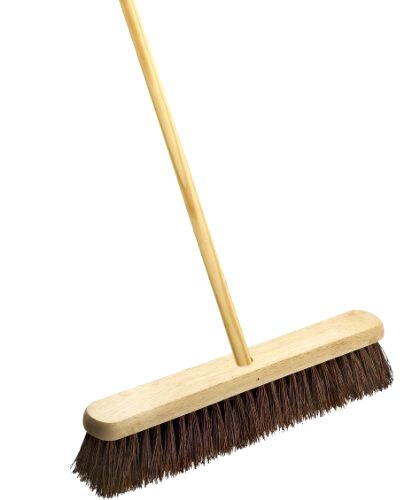
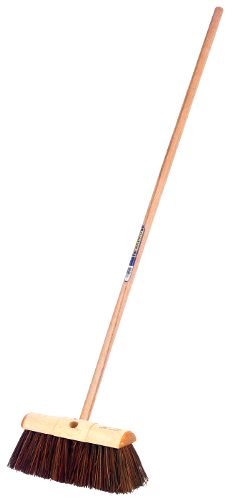
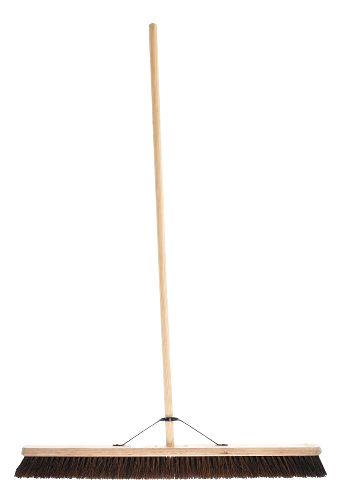
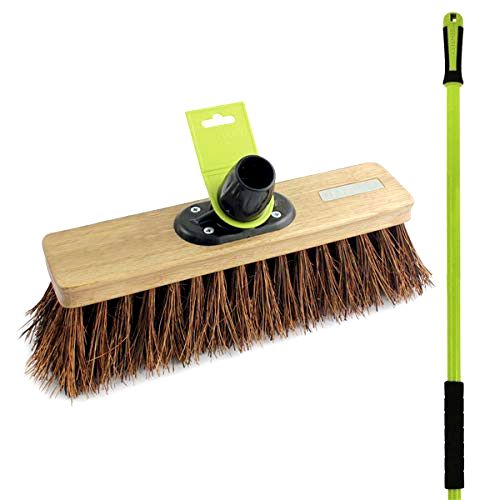
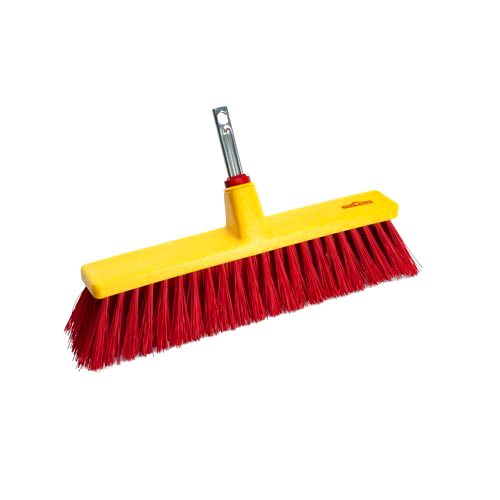

Share